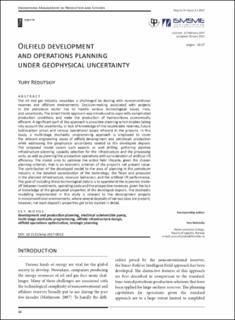| dc.description.abstract | The oil and gas industry nowadays is challenged by dealing with nonconventional reserves and offshore environments. Decision-making associated with projects in the petroleum sector has to handle various technological issues, risks, and uncertainty. The Smart Fields approach was introduced to cope with complicated production conditions and make the production of hydrocarbons economically efficient. A significant part of this approach is proactive planning which implies taking into account the uncertainty, or lack of knowledge of the recoverable reserves, future hydrocarbon prices and various operational issues inherent in the projects. In this study, a multi-stage stochastic programming approach is employed to cover the relevant engineering issues of oilfield development and petroleum production while addressing the geophysical uncertainty related to the developed deposit. The proposed model covers such aspects as well drilling, gathering pipeline infrastructure planning, capacity selection for the infrastructure and the processing units, as well as planning the production operations with consideration of artificial lift efficiency. The model aims to optimise the entire field lifecycle, given the chosen planning criterion, that is an economic criterion of the project’s net present value. The contribution of the developed model to the area of planning in the petroleum industry is the detailed consideration of the technology: the flows and pressures in the planned infrastructure, reservoir behaviour, and the artificial lift performance. The goal of including these technological details is to apprehend the economic trade-off between investments, operating costs and the prospective revenues, given the lack of knowledge of the geophysical properties of the developed deposit. The stochastic modelling implemented in this study is relevant to the development projects in nonconventional environments, where several deposits of various sizes are present; however, not each deposit's properties get to be studied in detail. | en_US |

